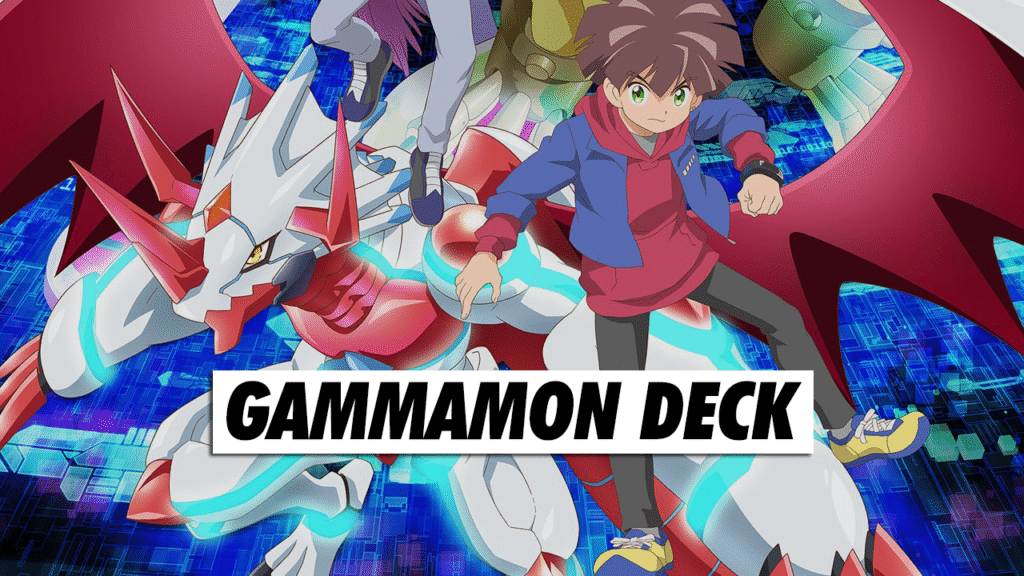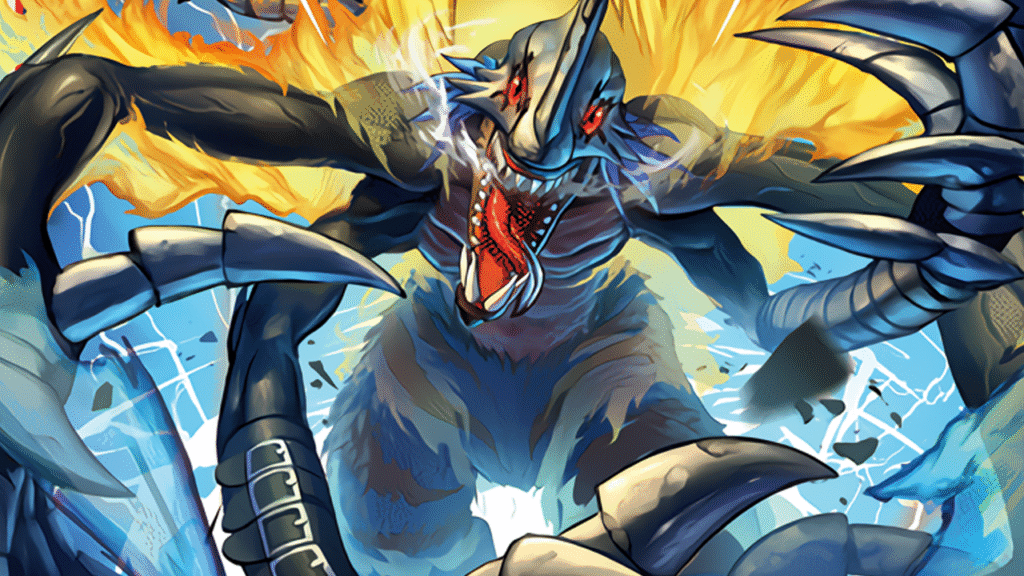Gammamon, BetelGammamon, and Hiro Amanokawa made their debut in the Digimon Trading Card Game back in New Awakening (BT-08). Despite appearing to be a relatively successful Digimon anime entry, Digimon: Ghost Game related decks have only received sporadic support, until World Convergence (BT-21) hit the scene.
World Convergence is the first set to share a world-wide release for the game — introducing the Appmon trait and Link keyword — while also spicing up the meta with a few new traits and decks, including our focus today:
Gammamon.
Introduction to the Deck
For enjoyers of the original Gammamon deck and its copy gimmick, you may find yourselves a bit disappointed that Bandai seems to be pushing Gammamon further into doing “Purple things.” While GulusGammamon, Regulusmon, Regulusmon ACE, and Arcturusmon were already a key part of how the deck functioned, the new support gives the deck access to consistent floating, deletion procs, and stickiness that was previously unavailable.
Thankfully, copy has some relevance in the deck and plays nicely into Gammamon’s new control play style. While the deck’s red side is still very much about building a big, scary boss-monster, it’s largely in service of setting traps for your opponent and using those traps to flip the tempo from “their game to win” to “your game to lose”.
So before we get into builds there are a few notes I’d like to make:
- The deck has some room for flexibility, and my playstyle may not fit your playstyle! Experiment liberally with the deck and see if you can find some nasty combos to pull off.
- While some of the “rainbow” Gammamon cards are generally not used in the deck, there may be instances where leveraging a Canoweissmon (BT-10) to gain the effects of KausGammamon and WezenGammamon can be a good idea, depending on your locals scene and your general gameplan for winning. Cards like Bombermon, Zanmetsumon, Ghilliedhumon, and Fumamon have some extremely niche use cases — but for our purposes today, they won’t be used.
- This deck can be pretty tricky to pilot in-person (something like DCGO helps automate a large amount of the trickiness), so it may take more time than usual to really master the deck.
Deck Builds
While there are no mandatory builds for this current version of Gammamon, the new support is certainly the core of the deck. These cards are:

- Gurimon (BT-21): 4 copies
- Gammamon (BT-21): 3-4 copies
- BetelGammamon (BT-21) 2-3 copies
- GulusGammamon (BT-21) 4 copies
- Canoweissmon (BT-21) 4 copies
- Regulusmon (BT-21) 2-3 copies
- Siriusmon (BT-21) 4 copies
- Hiro Amanokawa (BT-21) 3-4 copies
- The Strongest of Brothers (BT-21) 2-4 copies
From here, you can fill in most of the rest of the deck with these cards:

- Gammamon (RB1): 4 copies
- Gammamon (LM-016) 3-4 copies
- Bokomon (LM-019) 1-2 copies
- GulusGammamon (RB1) 3-4 copies
- Canoweissmon (BT-10) 0-2 copies
- Arcturusmon (RB1) 2-3 copies
- Hiro Amanokawa (RB1) 2-3 copies
Other cards to consider adding in:
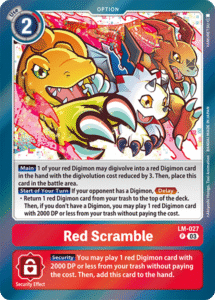
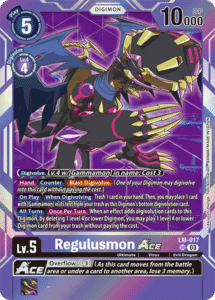

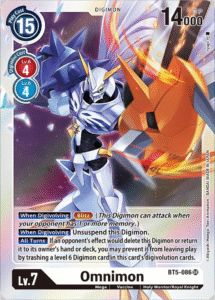
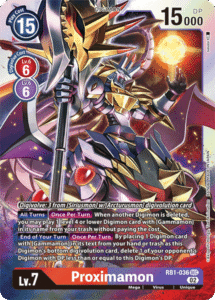
- Red Scramble (LM-027): if you forego Regulus ACE like I do, scramble synergizes decently with The Strongest of Brothers to keep evolution costs minimal, while maintaining turn or choking your opponent — it also helps get your Omnimons out of the trash if they end up there.
- Regulusmon ACE (LM-017): while I am not personally a fan of running an ACE in this deck (I like to lay traps, and ACEs reward my opponent for springing those traps), it’s not a bad option for those who have access to it. The synergy of being able to ACE into Regulusmon, tuck to trigger effects, then trigger the Siriusmon evolution deletion effect via The Strongest of Brothers is extremely powerful — especially when it’s all on their turn. Unfortunately, because a lot of decks have answers to ACE plays these days, you do open yourself for some immediate clap-back, even if it overextends them a bit. It’s by no means a bad card and depending on your Locals, may be a great option.
- Omnimon (X Antibody) (BT-20) / Omnimon (BT-05): this deck sorely needs a game finisher as it doesn’t have access to unsuspending outside of the Siriusmon (RB1) — which just isn’t that good, compared to either of your Omnimon options. For budget builders, Omnimon (BT-05) is quite good.
- Proximamon (RB1): While not a bad card, it’s also not an optimal card for the current version of the deck. If you have copies of it, feel free to use it! If you opt for Proxima over an Omnimon top end, consider running the new Agunimon (BT-21) so you can leverage the classic Hybrid-for-game play.
It bears repeating that you can flavor this deck how you like. Maybe you’ll leverage some of the other Gammamon support cards, or perhaps you find a strange tech that just works for how you play the game (or specifically foils a problem deck at your Locals). At the end of the day, the Digimon TCG is about having fun playing, and sometimes playing optimally doesn’t enable that.
That said, I’m going to discuss the deck from my particular build from here on out — I find it very fun and it’s helped me stay competitive against some of the more annoying decks out there.
My list:
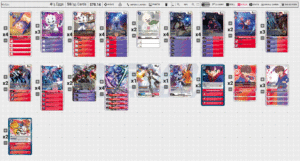
- Gurimon (BT-21) x4
- Gammamon (RB1) x4
- Gammamon (BT-21) x4
- Gammamon (LM-016) x3
- Bokomon (LM-019) x2
- BetelGammamon (BT-21) x2
- GulusGammamon (RB1) x4
- GulusGammamon (BT-21) x4
- Canoweissmon (BT-10) x2
- Canoweissmon (BT-21) x4
- Regulusmon (BT-21) x3
- Siriusmon (BT-21) x4
- Arcturusmon (RB1) x2
- Omnimon (X Antibody) (BT-20) x1
- Omnimon (BT-05) x1
- Hiro Amanokawa (BT-21) x3
- Hiro Amanokawa (RB1) x2
- The Strongest of Brothers (BT-21) x3
- Red Scramble (LM-027) x2
The Game Plan
The main goal is to build into Siriusmon and start swinging. How you get there is a different story. Early game, you should prioritize building your board. This might look like:
- Chip damage with a GulusGammamon (RB1) to trigger a free Gammamon (RB1) search or play out a Hiro Amanokawa via a Gammamon (LM-016) in sources effect. This play can be soft-looped if you have more than one GulusGammamon (RB1) in hand. However, keep in mind that chipping has some risk, and I only recommend doing this once, as it enables an OTK later.
- Hard playing The Strongest of Brothers (BT-21), tamers, or your searchers if your hand was suboptimal
After setting up, your goal should be to layer your stacks with on deletion traps, such as Digimon floats, Retaliation, or free tamers. Even if you’re in a favorable match up, I recommend prioritizing making your Siriusmon stack into an “effects bomb” as being able to float into multiple bodies and cheat out extra tamers can completely ruin your opponent’s momentum.
With all that said, rather than give you a play-by-play of how to run the deck, I’m going to break down how you can use each card, along with some of the combos and interactions you can leverage to win.
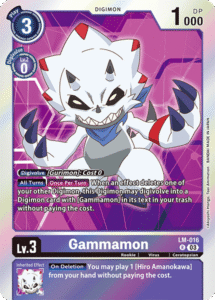

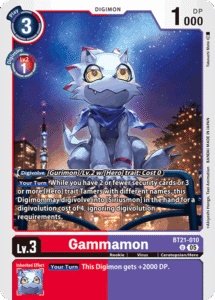
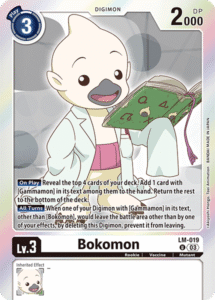
Rookies
Gammamon (LM-016) cheats out Hiros on deletion — making it a great option to tuck, if you suspect your stack is going to get deleted. It can also evolve from the trash when another digimon is deleted by effects, but that’s much trickier (and more expensive) to set up.
Gammamon (RB1) is your searcher for the deck. You can pick up a Gammamon in name/text and a Hiro Amanokawa from the search.
Gammamon (BT-21) can be used to memory choke, because you can choose to do a 1 memory cost evolution over your Gurimon (BT-21) egg. It can also synergize with Canoweissmon (BT-10) to enable you to digivolve a Siriusmon over a Siriusmon — more on that later.
Bokomon (LM-019) is a secondary searcher, but you can only grab one card from the search. Great in a pinch and gives you board-wide protection for all your Gammamon-in-text Digimon. A great way to counter Megidramon’s board-wipe effect!
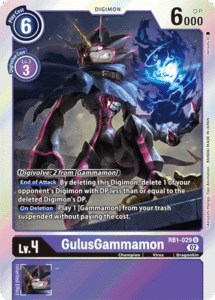

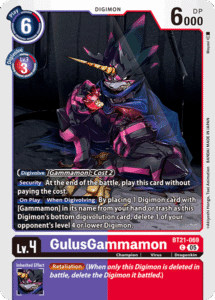
Champions
GulusGammamon (RB1) is your early chip damage vehicle. By evolving over a searcher or Gammamon (LM-016), you can attack early, delete your opponent’s Digimon (as long as it survives the security check), and play out a Gammamon from the trash. This has the added benefit of triggering Gammamon’s On Deletion: Play a Hiro effect, or giving you a free Gammamon (RB1) search.
BetelGammamon (BT-21) cheats out a Hiro on digivolution. Because it’s so easy to cheat out Hiros via Gammamon (LM-016), I prefer to use BetelGammamon as tucking-fodder to add +2000 DP to my Digimon.
GulusGammamon (BT-21) can tuck from hand or trash to delete a Level 4 or lower Digimon. It also gets to enter play if it’s checked in Security — legitimately a game winner at times. It’s a fantastic tempo stealer, and allows you to tuck for more DP, set up a free Hiro play via LM Gammamon, add double Retaliation to the stack to get around your opponents protection later, or set up a Gammamon float via GulusGammamon (RB1) (as long as you get a Canoweiss (BT-10) in the stack later).

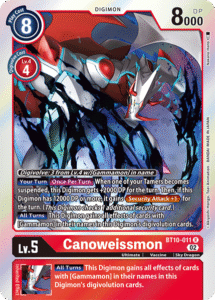
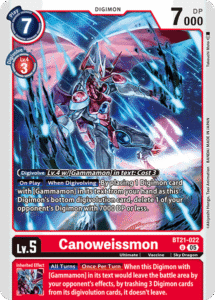
Ultimates
Regulusmon (BT-21) should almost always be evolved over a GulusGammamon (BT-21) since you can trash a card to taunt your opponent and give yourself Collision on their turn. Evolving over GulusGammamon (BT-21) gives you Retaliation, and can get rid of problematic Digimon. And, if you opt to trash a Canoweissmon, you can play it from trash On Deletion. My preferred use for this card is to try and get two of them into my Siriusmon (BT-21) stack so if it gets deleted, I can float into two Level 4 or lower Digimon.
Canoweissmon (BT-10) is mostly reserved for creating even bigger float plays or the very funny warp digivolve Siriusmon into Siriusmon play (this Canoweissmon copies all the abilities of Digimon with Gammamon in their name — meaning you can trigger Gammamon (BT-21)’s ability to warp digivolve into a Siriusmon for 4 memory. Besides the warp digivolve, with enough set up, you can get an extra security check on your first Siriusmon (BT-21) attack when you suspend a tamer while this Canoweissmon is on the board.
Canoweissmon (BT-21) gets to tuck a Digimon with Gammamon in text to delete a 7K DP or less Digimon. In a stack, its inherited ability also allows you trash 3 cards from sources to prevent removal by effects. While the DP deletion play can often whiff, it gives you the opportunity to set up a few things: an Arcturusmon (RB1) tuck so that when one of your opponent’s Digimon is deleted they trash a security, tuck a Canoweissmon (BT-10) for copy shenanigans, tuck another Canoweissmon (BT-21) for protection from removal effects, or add 2000 DP/Retaliation/Play Hiro on deletion.
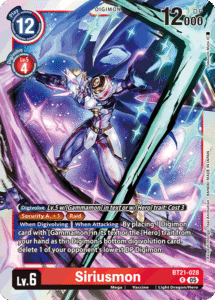
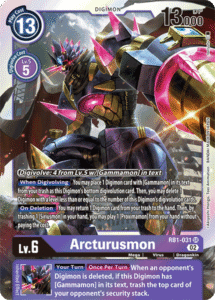
Megas
Siriusmon (BT-21) is where all your setup culminates: you get a huge effect bomb if you get deleted, but if you’re not deleted you get a lot of DP and two security checks per attack — with potential to trash security as well. When digivolving into Siriusmon, you get to tuck a Digimon with Gammamon in text or Hero trait from the hand to delete the lowest DP Digimon. After that, when you attack you get to do the same. If your opponent’s Digimon are immune to deletion effects, Raid is a huge help in swinging over them.
Arcturusmon (RB1) pretty much exists in this deck for being tuckable by Canoweissmon (BT-21) and Siriusmon (BT-21). As noted above, when your opponent’s Digimon are deleted, you can trash their top security. If you can get more than one of these in your stack, you can trash a security for each instance of Arcturusmon. This is your vehicle to set up an OTK turn!
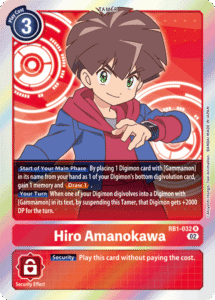
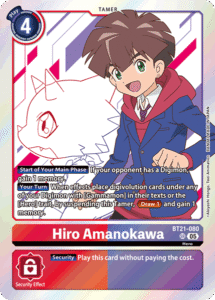
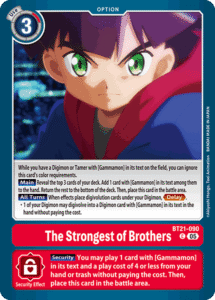

Tamers, Options, and Eggs
Hiro Amanokawa (BT-21) is a massive memory and draw engine for the deck, and synergizes well with Hiro Amanokawa (RB1). If you can get 2 or 3 of these Hiros on the board, you can get a guaranteed 4-6 memory per turn (as long as one of your Digimon has a card tucked underneath). Even 2 on the board makes things get out of hand for your opponent aggressively fast. He enables bigger plays by gaining memory, which can pull back memory to your turn. In concert with The Strongest of Brothers, it’s possible to cheat into one of your tucking Digimon, then gain memory and potentially draw into the pieces you need to keep tempo and put on incredible pressure.
Hiro Amanokawa (RB1) allows you to tuck a Gammamon underneath one of your Digimon on board. When this happens, you get to gain a memory and draw. This can trigger Hiro Amanokawa (BT-21) and The Strongest of Brothers, for extra memory and a free digivolution. When one of your Digimon Digivolves, you can suspend the tamer to give your digimon +2000 DP, which can be useful for swinging over big targets.
The Strongest of Brothers (BT-21) searches on play, then has a Delay function that allows one of your Digimon to Digivolve for free when a card is added tucked. If checked in Security you can play a 4 cost or less Gammamon in text from the hand or trash, then it enters the battle area. This can be a fantastic opportunity to get either a Bokomon (LM-019) onto the board for protection and a free search or another free Hiro Amanokawa.
Gurimon (BT-21) is the egg of the deck, which allows you to draw when you’re attacking. This is another reason why I enjoy attacking as early as possible with a GulusGammamon (RB1). Not only to I get the evolution draw, but I also get the draw from attacking. Paired with a potential free Gammamon (RB1) search, you can easily fill your hand with the cards you need.
Wrapping Up
I strongly believe that this deck is a bit of a dark horse for the World Convergence meta. It really shines when you play into its Purple strengths — it has excellent recursion and can easily punish your opponent for hitting security before they’re ready to close out the game.
It’s safe to assume that we’ll be getting new support in EX-10 (the villain themed set) — which may push the deck to even greater heights. If any of the pieces give the deck the ability to unsuspend with Blocker, or Rush, it could very well become a strong meta contender.
Let’s close out with a look at this deck’s strengths and weaknesses:
Strengths
- Extremely sticky with lots of effect removal protection
- Strong draw power and lots of searching
- Early game control is a breeze
- Excellent memory efficiency
- Easily plays the long-game against decks that like to draw things out
Weaknesses
- Lack of access to unsuspending and Blocker can doom a close match
- Few tools to thwart opponent if they have immunity
- Not seeing float pieces or The Strongest of Brothers slows things down
- It’s easy to railroad yourself into Siriusmon too early
- Learning to navigate the toolbox nature of the deck takes time
Thanks for reading, and I’ll catch you on the next deck profile!

